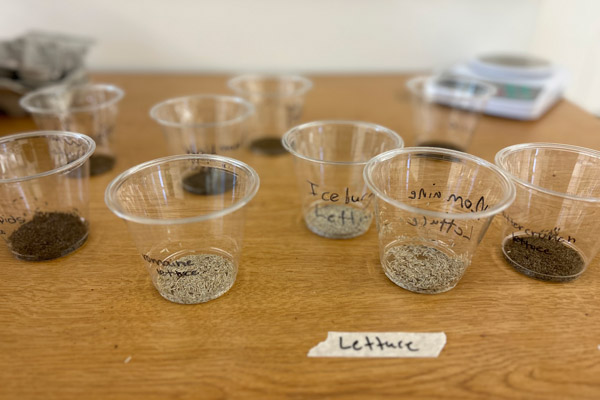Forest Hills — Every farmer has to contend with variables: from sunlight, to timing for planting, to crop choice. One variable that stays somewhat constant is the soil in which the plants grow. But what if that, too, was a variable?
Thanks to a $1,448 grant from the Forest Hills Foundation, Central Middle School students in Avery Barry’s Project Lead the Way class were able to experiment with simulated Martian soil known as regolith; the supplier claims it is “as close to Mars as you can get without leaving the Earth.”
NASA is one of the developers of the red material, made of ground basalt. Barry thinks the hands-on experience “is much more enriching than just analyzing graphs of plants being grown in space….”
During class, students teamed up to create a planning document and develop hypotheses about how seeds might grow in both Martian soil and Earth soil. Eighth-grader Addy McConnell worked with classmate Lauren Glupker, also in eighth grade, to choose English cucumber seeds for their experiment.
“The red soil might grow seeds just as well as Earth’s, but I don’t expect it to,” Addy speculated. “If it does, we could plant things on Mars.”
Nearby, seventh-graders Zariya Zaheer and Jaylen Scott talked about which lights to use to help the seeds that they said they chose at random, to grow.
‘We might want to change something in Earth’s soil if there are surprises in how the plants grow in Martian soil.’
— eighth-grader Addy McConnell
“A week ago, we got to see how different grow lights work. The red/blue showed the most growth on a graph, so we chose that one instead of the white or red,” Zariya explained.
Added Jaylen: “We’ll check on them every day.”
They guessed the seed planted in Earth soil would grow taller because it seemed to absorb more water. In fact, Barry talked to students early in the class period about watering the seeds in Martian soil slowly. Otherwise, she said, “The seeds will wash away because it’s so fine.”
‘This hands-on experience is much more enriching than just analyzing graphs of plants being grown in space….’
— Avery Barry, Central Middle School Project Lead the Way teacher
Other students thought a lot about watering technique as they prepared their egg-cup farms and created plans for tending the seeds. Seventh-graders Brayden Zawacki and Jaxson Chopp, and classmate Aarav Patel thought watering would be really important. They chose three different seeds to plant: romaine, chives, and iceberg lettuce. “Ones we’d like to eat,” Brayden said. Aarav added that they chose plants they can eat so they can taste them when they’re grown.

Over the next few weeks, students will tend the seeds and gather data as seeds sprout; hypotheses about whether or not Martian soil is effective in growing crops will be tested. Growth, rate of germination, height of plants and taste will be compared.
“Maybe some students will be mapping out their 10-year career plan to end up at NASA working on a team that will get us to Mars.’
— Avery Barry, Central Middle School Project Lead the Way teacher
This unit is part of Project Lead the Way’s Flight and Space curriculum, and it and other hands-on experiences, Barry knows, create opportunities to be scientifically literate and to use critical thinking.
Even more, some students may decide to pursue a career at NASA.
“The students in class right now could be future astronauts, or aerospace engineers or astrobiologists that are working on the front lines of innovation in space,” she said. “Maybe some students will be mapping out their 10-year career plan to end up at NASA working on a team that will get us to Mars.”
Some, too, may be innovators here on Earth.
Addy was open to the unexpected in the out-of-this-world experience.
“We might want to change something in Earth’s soil if there are surprises in how the plants grow in Martian soil,” she said.
Read more from Forest Hills:
• Next stop, Worlds!
• ‘I am here for them through it all’















